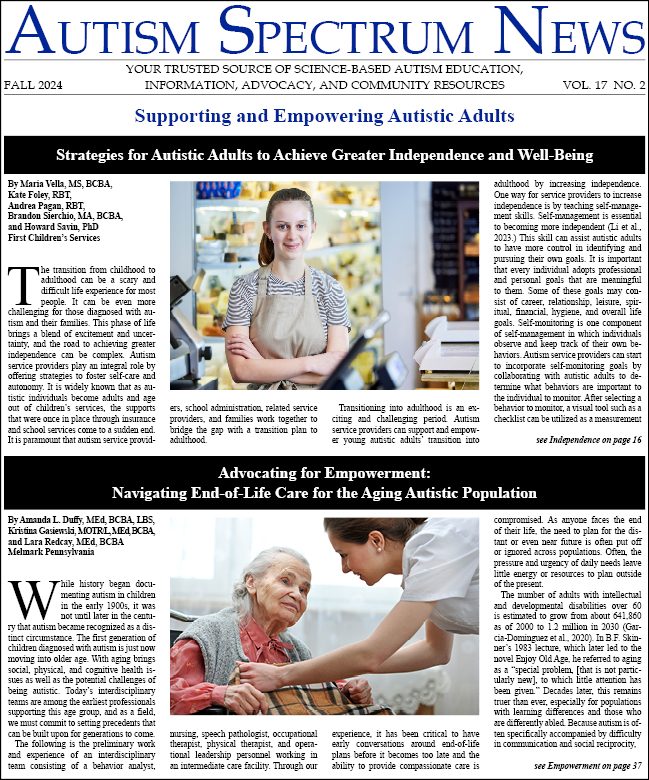-
Parents and Caregivers: What to Do if You Think Your Child is Autistic
My child has big emotional reactions and seems so sensitive to everything. I am always having to reassure my daughter when we go to new places or meet new people. My son wants to make friends so bad, but he has such a hard time knowing how to play with others. My daughter gets upset every time I...
-
A Person-Centered Collaborative Approach to Achieving Best Outcomes for Autistic Individuals with Co-Occurring Conditions
Autism Spectrum Disorder (ASD) is characterized by the presence of persistent deficits in social communication and social interaction across multiple contexts as well as restrictive, repetitive behavior, interests, or activities (American Psychiatric Association, 2013). Many individuals with ASD...
-
Strategies to Teach Key Foundation Skills to Young Children with Autism
Children with autism have both strong and weak points when it comes to learning – like all children. A significant tendency to progress at different rates across developmental domains is generally the case. Further, there can exist an uneven performance within a single area. Since language is a...
-
Presentation of Autism Spectrum Disorder in Females: Diagnostic Complexities and Implications for Clinicians
Autism Spectrum Disorder (ASD) is a neurodevelopmental disorder characterized by pervasive deficits in social communication and patterns of restricted, repetitive, stereotyped behaviors and interests (American Psychiatric Association, 2013). Beyond the main diagnostic criteria, however, there is...
-
Naturalistic Intervention in Classrooms: A Look at Classroom Pivotal Response Teaching
Classroom Pivotal Response Teaching, or CPRT, is a naturalistic behavioral intervention designed for classrooms serving students with autism spectrum disorder (ASD). CPRT was created by modifying an evidence-based practice called Pivotal Response Training (PRT), which strives to improve learning in...
-
Key Elements of Social Skills Groups in Schools
Autism Spectrum Disorders (ASDs) are characterized by impairments in the domains of social interaction, communication and behavior. For many individuals with ASDs, especially those with Asperger’s Disorder and high functioning autism, social interaction and communication difficulties can have the...
-
Make Inclusion Work! Reducing Behavioral Challenges in the Classroom for Children with an Autism Spectrum Disorder
In recent years, there has been an increased emphasis on including students with disabilities in the general education classroom. Over the years, Public Law 94-142, (Education for All Handicapped Children Act, 1975), which was most recently revised in 2004 under the Individuals with Disabilities...
-
Executive Functioning Enhancement for High School Students with ASD
Educators have made great strides in integrating students with autism spectrum disorders (ASD) into general education over the past several decades; however, at the secondary school level, these students still often experience serious difficulties. A major obstacle to success for adolescents on the...
-
From Assessment to Intervention: Strategies for Identifying and Monitoring Treatment Progress in ASD
Evidence based treatment and the assessment of treatment effectiveness are dependent upon the collection of data during the evaluation process providing information about symptoms, impairment and abilities in children with ASD. Such an assessment allows for a seamless transition from diagnosis to...
-
Traditional Education May Be the Biggest Barrier to a Meaningful Education
Unlike many disorders that are treatable with a pill or procedure, the most important form of treatment for an autism spectrum disorders (ASD) is education. However, the traditional special education model, notwithstanding the great advances made in public education, individualized programing and...





